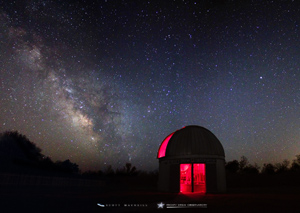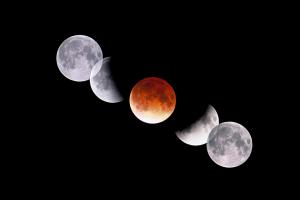
Public Stargazing
- Where:
- Frosty Drew Observatory
- When:
- Friday March 27, 2015 at 7:00 p.m.
- Cost:
- $1 Suggested Donation per Person
Tonight's forecast is calling for clouds, rain, and possibly snow after midnight. The first quarter Moon rose at 12:12 p.m. this afternoon and will stay with us until after midnight. Coming off a 6 month stretch of clear skies on almost every Friday night, we have had our telescopes closed since the turn of Spring. Though cloudy tonight, Spring brings our best viewing season to Frosty Drew Observatory as the Summer Milky Way returns to our skies. This past weekend the Milky Way made a fabulous appearance at the Observatory in the early morning hours showing off spectacular views. Don't let the dismal weather keep you down, awesome viewing is just around the corner.
We plan to open the Sky Theatre and Observatory from 7:00 p.m. - 9:00 p.m. tonight. In the Sky Theatre we will be showing slide shows of astrophotographs shot at Frosty Drew Observatory with a commentary and open discussion on general astronomy. The Observatory will be open for tours of our telescopes and facility with staff on hand to answer questions about how awesome science is for us.
So stop in for a quick chat with a few astro-geeks on a rainy night in southern New England. Then get excited for the arrival of our best viewing season at Frosty Drew!
-------------------------------------------------------------------------
Weekly Happenings
Scott MacNeill
These past couple weeks, in the hours before pre-dawn, the bright Summer Milky Way has returned to the New England skies. Like a storm moving in from the East, this region of the sky is loaded with fabulous nebulae, star clusters, and billions of stars. All that is needed to see it are dark wide open skies, exactly what Frosty Drew Observatory rocks at!
What is commonly known as the Summer Milky Way is actually the Sagittarius Arm of the Milky Way galaxy extending to the bright galactic center, which is slightly obscured by the dense Scutum-Centaurus Arm that cuts across our viewing plane. The distance from Earth to the galactic center is a mere 25,900 light years, where a super massive black hole, named Sagittarius A*, resides. Due to the extreme density of stars, gas, and dust along the galactic plane, our view beyond the galactic center is obscured.
Viewing the Summer Milky Way requires very dark skies and a wide open area free of trees and other obstructions. The Milky Way, though appearing quite bright, will be become invisible when accompanied by a bright moonlit sky. Setting out during the New Moon or on a night when the Moon sets early or rises late will give you the best opportunity to view the vast starscape of the Milky Way. Binoculars will offer hours of fabulous views as the abundance of star clusters and nebulae found along the Sagittarius and Scutum-Centaurus arms are just at or slightly beyond naked eye visibility.
Observing the Milky Way under clear dark skies gives us an insiders view point of a barred spiral galaxy. The vast distances observable accumulate into a combined background starlight instead of individual points of light. In my mind I relate the view to standing on the edge of a tall cliff, looking out into the expanse and feeling dizzy at the intangibility of the space. The Milky Way will continue to rise earlier every night as we move through Spring, eventually offering all night viewing in early June. Check out some of the photographs we have captured at Frosty Drew Observatory of the Milky Way galaxy.
On Saturday April 4, 2015 another Total Lunar Eclipse is taking place. Unfortunately, all of us in New England and most of the USA, for that matter, will not see the entire eclipse. Starting at 5:01 a.m. Saturday morning, the Moon will begin passing into Earth's secondary shadow, called the “penumbra”. This will appear as a very light shading of the left side of the Moon. Once 6:15 a.m. swings around, the Moon will begin to pass into the umbra, which is Earth's primary shadow. This will give us that classic chunk-missing-from-the-moon view that is commonly pictured when thinking about a lunar eclipse. For all of us in New England, the Moon will set at 6:24 a.m. marking the end of the lunar eclipse for us. Though, total eclipse will happen at 7:57 a.m. lasting only for 4.5 minutes due to the Moon passing into the very top of Earth's shadow. Eventually, 10:58 a.m. will bring the end of the lunar eclipse. Now don't get too beat up about missing most of this eclipse because on September 28, 2015 New England is going to get slammed with an entire total lunar eclipse starting at 8:11 p.m. and ending at 1:22 a.m. Woot!
-Scott


